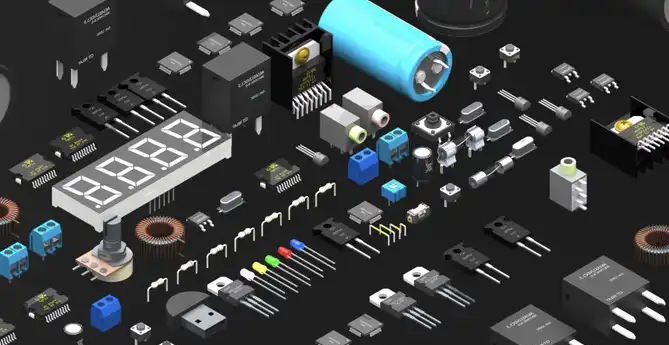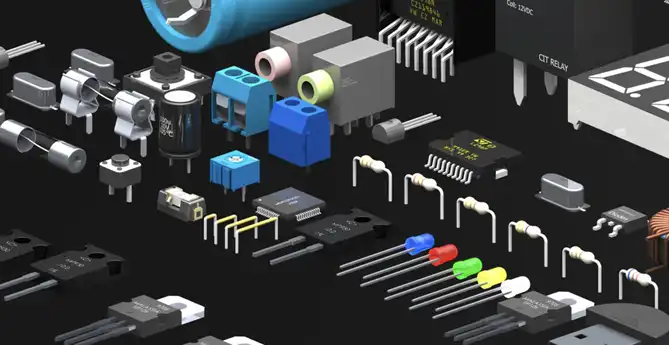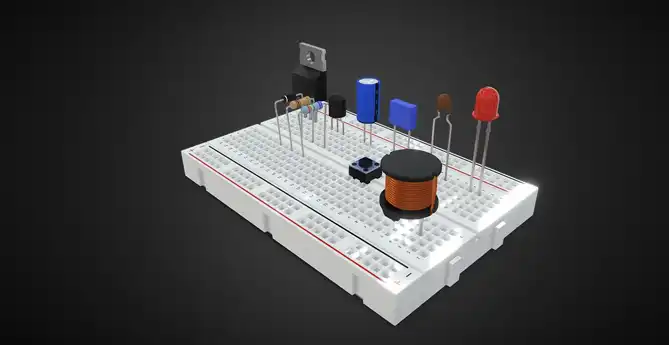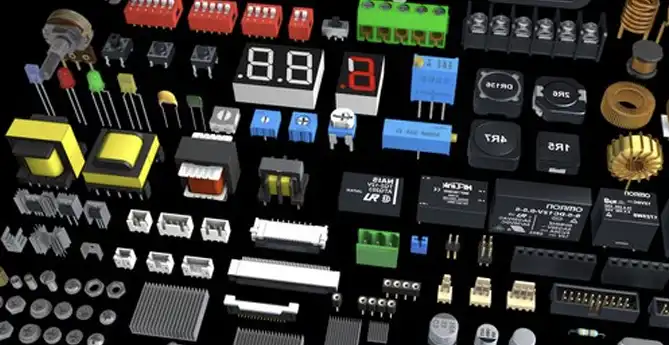3D modeling has become a cornerstone of innovation, particularly in electronic components. Designers and engineers seek accurate, accessible, and cost-effective 3D models to streamline their product development process. However, the quest for these models can often be daunting.
This comprehensive guide will navigate you through the labyrinth of obtaining free 3D models for electronic components, empowering you to bring your ideas to life with ease.
What Are Electronic Component 3d Models?

Electronic component 3D models are digital representations of various electronic parts and devices used in circuit design and product development.
These models accurately depict the physical characteristics and dimensions of electronic components, allowing engineers and designers to visualize how they fit within a circuit or assembly. They can include components such as resistors, capacitors, integrated circuits, connectors, switches, and more.
These 3D models are typically created using computer-aided design (CAD) software and are available in different file formats compatible with various CAD tools. Engineers and designers can use these models to simulate, test, and optimize their designs before actual production, saving time and resources in the development process.
Electronic component 3D models play a crucial role in prototyping, virtual testing, and documentation phases of product development. They enable engineers to identify potential design flaws, ensure proper fit and clearance, and communicate design concepts effectively with team members and stakeholders.
3D Step Models Electronic Components

The term “3D step models electronic components” refers to 3D models of electronic components saved in the STEP file format. STEP (Standard for the Exchange of Product model data) is a widely used file format for representing 3D models of mechanical and electronic parts in a standardized manner.
These 3D STEP models are essential resources for engineers, designers, and manufacturers involved in product development and design. Here are some key points regarding 3D STEP models of electronic components:
- Accurate Representation: 3D STEP models provide precise representations of electronic components, including their physical dimensions, shapes, and features. They capture intricate details such as pin configurations, mounting holes, and surface finishes, enabling accurate integration into design projects.
- Compatibility: STEP files are compatible with a wide range of computer-aided design (CAD) software applications, making them versatile and widely accessible. Engineers and designers can import STEP models into their preferred CAD tools without compatibility issues, facilitating seamless integration into design projects.
- Interoperability: The standardized nature of STEP files ensures interoperability between different CAD software platforms. This allows users to collaborate on design projects across different software environments, share models with colleagues and stakeholders, and maintain consistency throughout the design process.
- Ease of Use: 3D STEP models of electronic components are user-friendly and easy to work with. Designers can manipulate, modify, and incorporate these models into their designs with ease, speeding up the design iteration process and improving overall efficiency.
- Availability: Many electronic component manufacturers provide 3D STEP models of their products on their websites or through online repositories. Additionally, various online platforms and communities offer libraries of free STEP models contributed by users worldwide, covering a wide range of electronic components.
In summary, 3D STEP models of electronic components are invaluable assets for engineers and designers, offering accurate representations, compatibility, interoperability, ease of use, and wide availability. By leveraging these models, design professionals can streamline their design process, optimize product development, and bring their ideas to fruition with precision and efficiency.
What Are 3d Model Electronic Components Used For

3D models of electronic components serve various purposes across different stages of product development and design processes.
Here are some common uses:
Visualization: 3D models allow engineers and designers to visualize electronic components within the context of their designs. This helps in understanding how the components will fit together, their relative sizes, and how they interact with other parts of the system.
Prototyping: Before physical prototypes are created, engineers can use 3D models to virtually assemble and test their designs. This enables them to identify any potential issues or conflicts early in the development process, saving time and resources.
Simulation: Engineers can simulate the behavior of electronic components within a larger system using 3D models. This allows them to analyze performance, test different configurations, and optimize designs for efficiency and reliability.
Documentation: 3D models are often used to create detailed documentation for electronic products. This includes technical drawings, assembly instructions, and part lists, which are essential for manufacturing and assembly processes.
Communication: 3D models serve as effective communication tools, allowing engineers to convey design concepts and ideas to colleagues, clients, and stakeholders. Visualizing designs in 3D helps facilitate discussions and decision-making processes.
Training: Electronic component 3D models can be used for training purposes, especially in educational settings or within organizations. They provide hands-on learning experiences without the need for physical components, enhancing understanding and knowledge retention.
3D models of electronic components play a vital role in streamlining the product development process, improving design accuracy, and accelerating time-to-market for electronic products and systems.
Where to Get Electronic Components 3d Models Free

Finding free electronic component 3D models is crucial for designers and engineers looking to optimize their design process without incurring additional costs.
Here are some reliable sources where you can obtain electronic component 3D models for free:
Online Repositories: Numerous online platforms offer extensive libraries of free 3D models for electronic components. Websites like Thingiverse, GrabCAD, and FreeCAD provide a vast collection of models contributed by users worldwide. These repositories cover a wide range of components and are often accompanied by user reviews and ratings.
Electronic Component Manufacturers:
Many electronic component manufacturers offer free 3D models of their products on their websites. These models are typically accurate representations of the actual components and are available for download in various CAD formats. Manufacturers like Texas Instruments, Analog Devices, and STMicroelectronics provide comprehensive libraries of 3D models for their components.
Community Forums:
Online forums and communities dedicated to 3D modeling and electronics often share free 3D models contributed by members. Websites like Reddit’s r/3Dprinting and r/CAD, as well as forums like Electronics-Lab and Arduino, are excellent sources for finding electronic component 3D models shared by enthusiasts and professionals.
Open-Source Projects:
Open-source hardware projects and initiatives often provide free access to their design files and 3D models. Platforms like GitHub host repositories of open-source electronic projects, including 3D models of components used in these projects. Exploring repositories related to Arduino, Raspberry Pi, and other popular platforms can yield valuable resources.
CAD Software Libraries:
Some CAD software packages come with built-in libraries of electronic component 3D models. For example, Fusion 360, SolidWorks, and AutoCAD offer extensive libraries of standard components that users can access for free. These libraries are continuously updated and provide high-quality models for use in design projects.
Here are some websites that you can find electronic component 3D models:
- SnapEDA
- Component Search Engine
- UltraLibrarian
- Octopart
- 3DContentCentral
- Solidworks
- GrabCAD
- TraceParts
- DesignSpark 3d Zone
- 3DWarehouse
- PCB-3D
- Turbosquid
- SketchFab
By leveraging these sources, designers and engineers can access a wealth of free electronic component 3D models to enhance their design process and bring their ideas to life with ease.
FAQs
How can I ensure the quality of free 3D models for electronic components?
Quality assurance is vital when sourcing free 3D models. Always verify the reputation of the platform or community providing the models. Additionally, examine user reviews and ratings to gauge the reliability and accuracy of the models.
Are there any legal implications associated with using free 3D models?
While many platforms offer free 3D models for electronic components, it’s essential to review the licensing agreements associated with each model. Some models may have restrictions on commercial use or require attribution to the original creator.
What are some advanced search techniques to optimize my quest for free 3D models?
To refine your search results, consider using Boolean operators, wildcard characters, and specific file format filters. Additionally, explore niche platforms tailored to 3D modeling enthusiasts and professionals.
Can I customize free 3D models to suit my project requirements?
Yes, many free 3D models come with editable source files, allowing you to tailor them to your specific needs. However, always respect the original creator’s licensing terms and give proper attribution if required.
How can I contribute to the community of free 3D model enthusiasts?
Consider sharing your own creations on community forums and repositories. Collaborate with fellow designers and contribute feedback to help improve the quality and accessibility of free 3D models for everyone.
What are the benefits of incorporating free 3D models into my design workflow?
Integrating free 3D models into your workflow can significantly accelerate the product development process, reduce design iteration time, and foster collaboration among team members. Additionally, it enables cost savings by eliminating the need to purchase individual models.
Conclusion
In conclusion, accessing free 3D models for electronic components is a game-changer for designers and engineers alike. By leveraging the wealth of resources available online, you can unlock unlimited creative potential and propel your projects to new heights. Remember to prioritize quality, legality, and integration into your workflow to maximize the benefits of these invaluable assets.